Indoor Bsketball Lighting Design: Basketball Court TV Lighting Levels

Directory:
1. Analysis and Modeling
2. Indoor Basketball Court Lighting Design and Simulation
Lighting plays a crucial role in the effective operation of sports venues and television broadcasts. It is essential for sports lighting to create a high-quality environment for athletes and referees while also providing an enjoyable viewing experience for spectators and meeting the lighting needs for TV broadcasts. When designing lighting schemes, the capabilities of the DIALux lighting software can be effectively utilized to gain a clear and intuitive understanding of the proposed lighting arrangement. This allows for the optimization of lamp placement, adjustment of lamp quantities, and the development of the best lighting design solution, along with generating reports such as illuminance contour maps, point illuminance maps, and glare indices. This paper will focus on the lighting design and modeling simulation for indoor basketball courts, considering four key aspects: light source selection, lamp distribution curve selection, lamp arrangement, and lamp control methods.
1. Analysis and Modeling
In designing lighting for sports venues, it is important to consider the venue's level and the specific requirements of different sports. This paper focuses on the lighting design and simulation for indoor basketball courts, using the lighting standards for basketball courts in China as the benchmark for the simulation, as detailed in Table 1.
table1 basketball court lighting levels (TV lighting level)

In accordance with basketball court design standards, a Class II indoor sports stadium measuring 40m in length, 30m in width, and 13m in height has been modeled in DIALux, with a standard illumination level of 500lx for the design.
2. Indoor Basketball Court Lighting Design and Simulation
2.1 Light Source Selection
Metal halide and LED lamps are frequently utilized for sports lighting. Given the height of the stadium, high-powered lamps are necessary to fulfill the lighting requirements. Metal halide lamps are powerful and have well-established technical specifications, making them widely used. On the other hand, LED lamps offer advantages over metal halide lamps in terms of energy efficiency, lifespan, flicker, and dimming capabilities. However, high-powered LED lamps still have significant potential for improvement in terms of heat dissipation, size, and weight.
To find the optimal solution, a starry sky lamp arrangement method was employed to simulate and calculate the performance of both metal halide and LED lamps. The metal halide lamp selected is the MPK45 from a specific brand, while the LED lamp is the BY471P from the same brand. To meet the 500lx illumination standard, calculations and simulations under the full-sky lamp arrangement revealed that 48 metal halide lamps are needed, totaling 20.592W, and 36 LED lamps are required, totaling 7.200W. The simulation results are illustrated in Figure 1 and Table 2.
table2 Light source simulation results

fig1 Illuminance contours of indoor basketball courts with different light sources

Table 2 shows that in order to attain equivalent average illumination and uniformity, there are 12 more metal halide lamps compared to LED lamps, resulting in a total power difference of 13.392W. The power density for metal halide lamps is 17.16W/m2. while for LED lamps it is 6W/m2. This indicates that metal halide lamps use significantly more energy than LED lamps. Given the energy-saving benefits and superior performance of LED lamps, they are clearly the better option.
2.2 Selection of Lamp Lighting Curves
Lamps exhibit three types of lighting curves: narrow, medium, and wide, which influence the variation in illumination. This study utilizes three different metal halide lamp fixtures from the HPK888 brand for design simulations. The lighting curves are illustrated in Figure 2.
Using DIALux for calculations and simulations, it was determined that to meet the illumination standard of 500lx in a full-star arrangement, 42 wide lighting fixtures are necessary. The narrow and medium lighting fixtures were also arranged in the same manner for comparison purposes. The simulation outcomes are presented in Figure 3 and Table 3.
table3 Simulation results of the light distribution curve of lamps
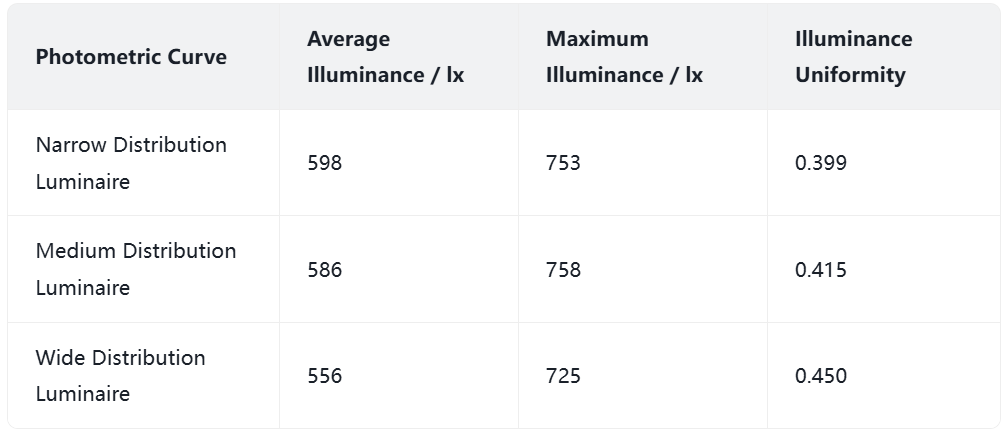
fig2 Light distribution curve
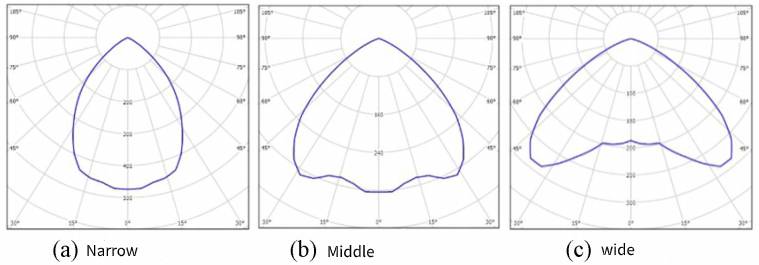
fig3 Illuminance contour lines for different lighting distribution curves of indoor basketball court lamps

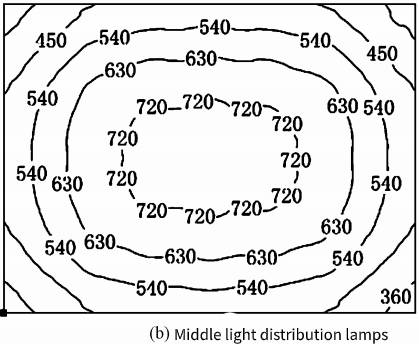
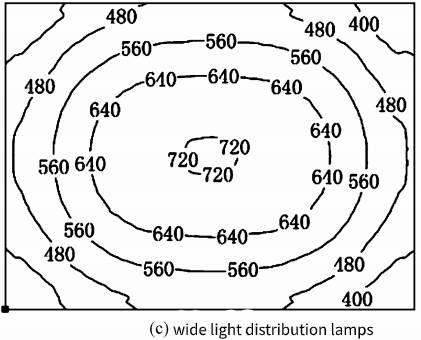
Table 3 indicates that with the same lighting setup, a narrower light distribution curve results in higher lamp illumination, but this comes at the cost of reduced illumination uniformity. Sports venues require comfortable lighting, and it is essential that illumination uniformity does not interfere with sports activities and competitions. Additionally, the illumination must meet standard values. Therefore, the selection of lamps should be based on the specific needs of the venue, opting for lamps with suitable light distribution curves. For instance, narrow light distribution lamps are ideal for tall and spacious venues to fulfill illumination requirements, while medium light distribution lamps are more appropriate for lower spaces like training halls and amateur competition areas.
2.3 Lighting Arrangement Methods
The typical lighting arrangements for gymnasiums include top arrangement, two-side arrangement, and mixed arrangement. Symmetrical lighting fixtures are best for top layouts, which are ideal for gymnasiums with low ceilings and no TV broadcast needs, commonly found in amateur training and recreational facilities. Asymmetric lighting fixtures are used for side arrangements, positioned along the horseway, with the aiming angle of the lamps (the angle between the lamp's aiming direction and the vertical line) set between 25° and 65°. This setup is suitable for large and medium-sized gymnasiums that require high vertical illumination and are equipped for TV broadcasts. The mixed layout combines both top and side arrangements, allowing for a variety of lighting options to meet diverse illumination needs, making it suitable for large multi-purpose gymnasiums.
In this study, both side and top layouts were simulated using metal halide lamps, specifically the MPK450 model with a power of 500W per lamp. Based on a standard illumination level of 500lx, calculations and simulations determined that 46 lamps are required for the two-side arrangement and 48 lamps for the top arrangement. The simulation results are presented in Figure 4 and Table 4.
fig4 Indoor basketball court lighting arrangement method Illuminance contour lines at different times
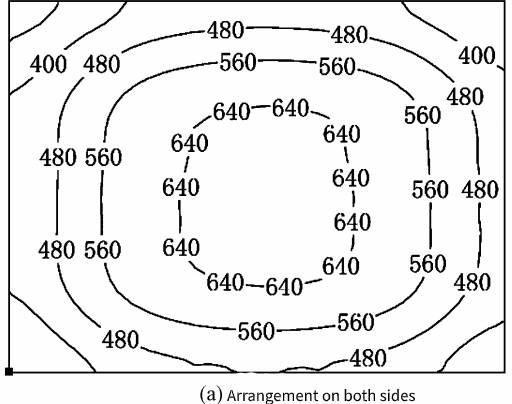
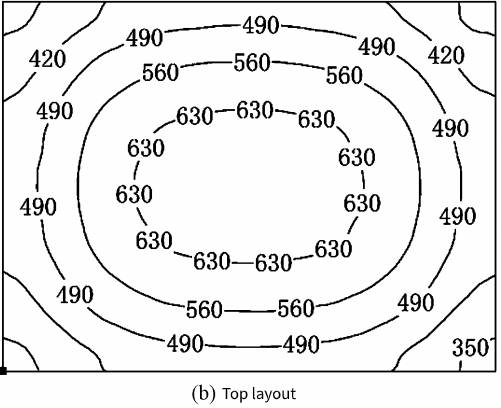
According to Table 4. the lighting standards for the two-side setup and the top setup are comparable; however, the top setup includes 2 additional lamps and has a total power increase of 1.000W, resulting in higher investment and operating expenses.
table4 Simulation results of lamp arrangement

Furthermore, when designing the lighting for the basketball court, it is important to take glare into account. In the lighting simulation, since the venue is rectangular and the lights are positioned overhead, the sampling points for glare values should be evenly distributed and symmetrical. The locations of these glare value sampling points are illustrated in Figure 5.
fig5 Glare value sampling point location
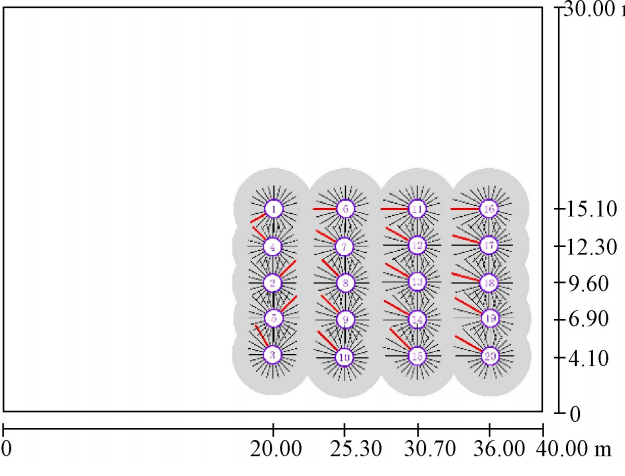
In the two-side configuration, the glare values range from a minimum of 13 to a maximum of 18. while in the top configuration, they range from 11 to 17. Although the glare value for the two-side setup is marginally higher than that of the top setup, it remains compliant with the standard requirements outlined in Table 1.
2.4 Lamp Control
Gymnasiums are utilized not only for amateur competitions but also for entertainment events and regular training sessions. This paper proposes three modes for controlling the lighting: amateur competition mode, entertainment mode, and cleaning mode, with respective illumination levels of 500lx, 300lx, and 150lx. Based on calculations and DIALux simulations, the required number of lamps for the overhead lighting configuration is 36. 24. and 12 for each mode. The chosen lamp is the BY471P model, which has a power rating of 200W and a luminous output of 25.000lm.
table5 Lighting control mode simulation results
Table 5 provides a summary of the simulation results for the three modes.
The lighting power consumption differs significantly across the various modes. By adjusting the number of lamps based on the venue's usage periods, energy can be effectively conserved. Furthermore, to standardize the operation and maintenance schedules for all lamps, the lamp control strategy should incorporate a rotation system to simplify maintenance and repairs for staff.
Currently, while LED lamps are not as prevalent as halogen lamps, their numerous benefits—such as energy efficiency, longevity, and dimmable features—indicate that they will become the dominant choice in the future. The selection of lamp distribution curves—narrow, medium, or wide—should be based on the specific conditions of the venue. A narrower light distribution curve results in higher illumination. The primary lighting arrangement methods for indoor stadiums include top layout, two-side layout, and mixed layout. The top layout offers better uniformity in illumination but lower vertical illumination; the two-side layout provides high vertical illumination and is easier to maintain; while the mixed layout can accommodate various illumination needs. Utilizing multiple lighting control modes in sports venues demonstrates a clear energy-saving benefit.
3. Related Product

4. Related Blog